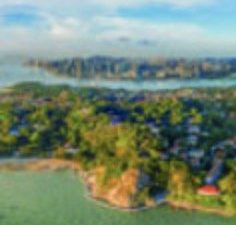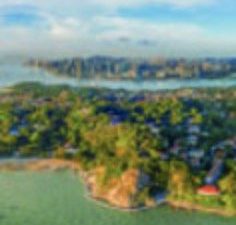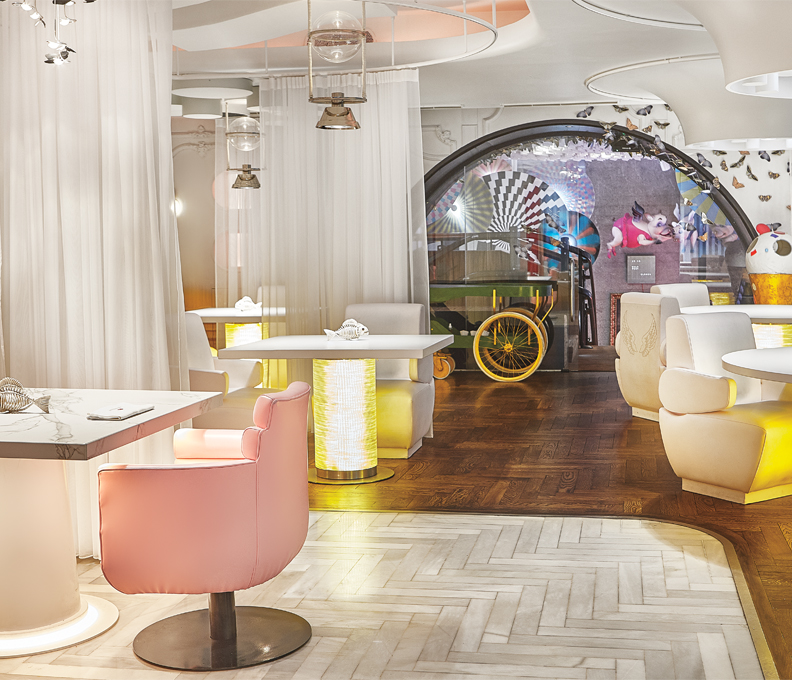Garden City
September 30, 2017

Arriving at Xiamen Gaoqi International Airport is a painless affair by Chinese standards. Medium sized and modern – a new terminal was opened in 2014 – it receives flights from more than a dozen international carriers. It is also home to Xiamen Airlines, one of the country’s expansive young airlines, as well as Goodrich TAECO, one of China’s first OEM repair and overhaul facility. As a result, the airline operates fairly smoothly.
Xiamen has plenty of experience in dealing with foreigners, dating back to its inclusion as a Treaty Port in the 1842 Treaty of Nanking after the First Opium War. Then, international residents lived on the small islet of Gulangyu, the only official international settlement outside Shanghai. However, the Xiamen of those times has all but disappeared, as is apparent when you drive down one of many elevated expressways that crisscross the island, allowing the tree-lined street-level roads to be quite navigable.
There’s also a noticeable lack of rubbish, plenty of parks and green-swathed hills scattered across the island, making it easy to believe Xiamen’s accolade as one of China’s most livable cities. There’s also more of a relaxed atmosphere here, similar to a seaside resort town rather than a busy center of commerce – and yet Xiamen is both of these things.
The island of Xiamen, part of Fujian province and separated from the mainland by the deepwater port of Xiamen Bay, is only 186 miles from Taiwan and has been a thriving trading center for many centuries. However, the modern city has outgrown its island borders, annexing six districts. Still, the majority of international visitors will still arrive and stay on Xiamen island, which spans nearly 10 miles from north to south and six from east to west.
A sub-provincial level city, Xiamen is one of China’s five special economic zones and is highly competitive thanks to its port status – it receives international cruise ships and considerable maritime cargo trade – and its geographic location close to Taiwan (and consequent close business links). It also benefits from well-developed domestic and international air links and a high-speed rail network connecting it to Hong Kong and Guangzhou in the south, and Shanghai to the north.
Taking Care of Business
The old town and main CBD can be found in the southwest of the island, though development in recent decades has seen the business district spread inland. The airport is situated in the north, while in the area around Wuyuan Bay construction is rampant, with the northeast of the island developing as a new business district.
A second international airport is planned to open in 2020 on Dadeng Island and Beijing has included Xiamen as a core part of the Fujian Pilot Free Trade Zone, positioning the city as a Cross-Strait Financial and Trade Centre, and a strategic pivot point for the 21st Century Maritime Silk Road.
The city’s pillar industries are electronics, commercial shipping, machinery, finance and software/IT services. Dell was an early entrant, and Lenovo, Prima Electronics, Amoi Electronics and NEC are other major investors in the electronics sector, while King Long Motor and XGMA Machinery Corp lead the engineering field.
Xiamen is the world’s largest producer and exporter of tungsten products, and is a major exporter of computers and digital audiovisual devices, capacitors, etc. Business is indeed booming – by early 2014, 55 Fortune 500 companies had set up business here, investing in 100 projects to the value of $5.7 billion.
In 2014 gross domestic product reached RMB327.3 billion ($49.8 billion), a per capita equivalent of $14,000, ranking Xiamen top among China’s medium-sized cities. The population in 2013 was 3.7 million, although unconfirmed reports place the current figure at closer to five million– a consequence of the burgeoning job market and Xiamen’s reputation as a great place to live, work and play.
The MICE industry is a major focus for city authorities, who want to build on an already strong foundation of major domestic and international exhibitions and events. The nation’s largest global investment event, the China International Fair for Investment and Trade (CIFIT) is held every September at the crown jewel of the city’s 17 exhibition venues, the Xiamen International Conference & Exhibition Centre on the island’s east coast.
The venue, which boasts 1.6 million square feet of indoor space, is adjacent to the Xiamen International Convention Centre, while on the south coast Xiamen University has extensive event venues as well. There’s still room for more, though – the Straits Tourism and Convention & Exhibition Centre is scheduled to open sometime this year.
Another big revenue generator is tourism. Blessed with a mild climate (average annual temperature is 70 degrees), a seaside location, interesting history and renowned seafood-inspired cuisine, Xiamen is one of China’s ten most popular tourist destinations. In 2013, a total of 46.64 million domestic and overseas tourists visited, bringing in tourism revenue of RMB62.1 billion ($9.5 billion), an upward trend has only continued in the last few years.
Taking It Easy
The small island of Gulangyu is Xiamen’s most famous tourist hotspot. Its winding alleyways reveal a variety of old colonial houses and lead to great views of the city from Sunlight Rock, sandy beaches or the large statue of the ancient Chinese military leader Koxinga. China’s only piano museum is also found here. Locals can reach Gulangyu in five minutes from the ferry pier on Xiamen’s facing coast, but foreigners must now catch a ferry from the International Cruise Terminal on the west coast – a 45-minute boat ride costs RMB35 ($5) each way.
Near the local Gulangyu ferry is Zhongshan Lu, a pedestrianized street lined with old shophouses that have been turned into souvenir shops and local retailers, plus a cornucopia of eateries.
Intriguing alleyways leading off the thoroughfare are worth exploring as you wander. A short drive east brings you to Nanputuo Temple, the peaceful Wanshi Botanical Garden and the Qing-era Hulishan Fortress.
Visitors staying close to Yundang Lake should join the locals for a stroll around the lake or over the pedestrian bridges into Bailuzhou Park in its midst. Xianyue Park is also worth visiting with its many paths leading to pagodas, temples, gardens and viewing points. And if you happen to find yourself on the mainland, the Xiamen Ling-ling International Circus in Jimei district makes for a memorable evening, its 165-foot-tall grand theatre holding audiences of 10,000 people.
Looking for a taste of Xiamen, you’ll find Fujianese cuisine is heavily seafood based, combining Taiwanese and Chaoshan flavors, and is renowned for its freshness and light spiciness. Famous snacks include Nanputuo vegetables, peanut soup, fried clams, Xiamen pie, leek pancakes and sea worm jelly. Noodle soup using shacha (shrimp-based) paste is particularly tasty – a bit like dan-dan soup but lighter.
Zhongshan Lu is a great place to sample some of these dishes, but many of the major hotels’ restaurants also offer superb examples of local cuisine – the Westin Xiamen’s Zen5es is a favored dining spot for this, as is Marco Polo’s Lotus Court.
In the evening the Coffee Street and Bar Street areas near the Marco Polo Xiamen hotel are popular haunts for locals and expats alike, while on the west coast Haiwan Park has a colorful nightlife scene with live music, bars and restaurants.
The Hospitality Scene
Given the joint drivers of business and tourism growth, it’s not surprising to find a huge choice of well-known international hotel brands in Xiamen.
Although a taxi ride from one side of the island to the other rarely takes more than 30 minutes, location is important. One hotel with an advantage in that department is Marco Polo Xiamen (marcopolohotels.com). With Yundang Lake just across the road, this 20-year-old, 300-room luxury hotel was renovated in 2010 and known for its combination of traditional style, modernized rooms and great dining options.
Also in this lower downtown area is the 29-story Pan Pacific Xiamen (panpacific.com/xiamen), offering 354 rooms and fully serviced suites, while farther inland but still beside the lake is the Pullman Xiamen Powerlong (pullmanhotels.com), which opened in 2002 but was rebranded a Pullman in 2012, providing three floors of dedicated executive rooms.
On the south side of Yundang Lake is the 460-room Kempinski Xiamen (kempinski.com). This elegant property offers 28,000 square feet of event space and a 22nd-floor executive lounge with magnificent views, and Kempinski’s signature beer hall Paulaner Bräuhaus is a popular meeting spot.
Just south of Xianyue Park the Westin Xiamen (starwoodhotels.com/westin), in an iconic downtown high-rise, offers similar levels of grandeur in its entrance lobby, plus Fujian’s highest executive lounge on the 40th floor. The Westin’s excellent F&B outlets include the Latin-themed Qba and Chinese restaurant Zen5es.
Also in the inland district are the 327-room Crowne Plaza Paragon Xiamen (crowneplaza.com), part of a retail complex; and the Sheraton Xiamen (sheraton.com/xiamen), almost ten years old but undergoing extensive renovations that will see its events rooms finished in September.
In August last year the 22-story Doubletree by Hilton Xiamen – Wuyuan Bay (doubletree.hilton.com) with 270 rooms opened in the northeastern corner of Xiamen island that is undergoing massive development. Another Doubletree is scheduled to open in Haicang district on the mainland at the end of the year.
Also in the northeast, but closer to the island’s main convention center is the 319-room Langham Place Xiamen (langhamhotels.com/xiamen), which opened in 2014 next to Wanda Plaza and close to a software industrial park. Finally, down on the south coast opposite Gulangyu is Hotel Indigo Xiamen (ichotelsgroup.com/hotelindigo), a midscale boutique property that offers a more trendy, boutique atmosphere in the touristy part of town.
Beyond this selection of existing properties, hotels including a Shangri-La, W Hotel, Wyndham, JW Marriott, Hualuxe and Hyatt Regency are all slated to open in the next few years – ramping up the competition considerably.
By Jeremy Tredinnick




